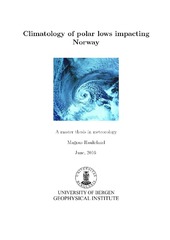Climatology of polar lows impacting Norway
Master thesis
Permanent lenke
https://hdl.handle.net/1956/12648Utgivelsesdato
2016-06-01Metadata
Vis full innførselSamlinger
- Geophysical Institute [1198]
Sammendrag
Polar lows (PLs), mesoscale cyclones in high latitudes, impacting Norway are studied in this thesis. A climatology of PLs in the Nordic seas for the period 1979-2015 is made, by applying a cyclone detection and tracking algorithm to reanalysis data. Western Svalbard, northwestern Russia, Novaya Zemlya and the northern coast of Norway are found to be the areas with the most landfall of PLs. PLs are found to reach areas designated to fishery and oil platforms, the most affected fishery area being south of Svalbard. A higher number of PLs is found to reach Norway compared to previous climatologies, suggesting that other types of cyclones might be included by the algorithm. The temporal distribution of PLs making landfall in Norway shows a rather large annual variability, with December, January and February as the months with the most PL events. A sensitivity analysis shows that more PLs making landfall in Norway is found for a forward shear environment compared to a reversed shear environment, and that a negative phase of the Scandinavian blocking is the most favorable low-frequency atmospheric variability pattern for PLs making landfall in Norway. A climatology of PLs in the Nordic seas for future climate scenarios shows a reduction of PLs in the 21st century, more prominent for a larger anthropogenic climate forcing. The changes are however small compared to previous climatologies on PLs.
